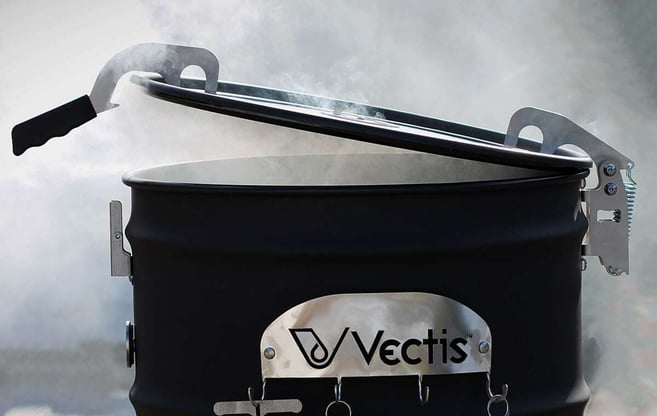
Designing anything with a moving part involves one constant: something must control the motion.
Whether it’s a heavy lid, a compact panel, or a rotating arm, the hinge often carries the responsibility. But in many innovative projects, a standard hinge simply doesn’t cut it.
Off-the-shelf hardware rarely fits one-of-a-kind applications. When working with unconventional forms, materials, or functionality, you need solutions that go beyond basic pivoting.
Let’s see how unique hinge design can solve even the most specific engineering problems. We’ll highlight custom hinge design strategies and walk through examples of unusual hinges — from concealed mechanisms to dual-axis solutions.
The Limits of Standard Hinges
Standard hinges are suitable for straightforward applications, such as simple doors, cabinets, and access panels. But in specialized equipment, high-end consumer products, or architectural features, catalog options often fall short.
Here’s why off-the-shelf hinges often fail in demanding applications:
- Load limitations: Stock hinges aren't designed to support heavy industrial doors or oversized equipment panels. Over time, they wear out or fail.
- Lack of motion control: Most standard hinges can’t manage soft-closing, damping, or multi-position holds.
- Poor fit for irregular shapes: Curved panels or tight spaces often need offset or low-profile movement, which is not easily found in catalogs.
- Short lifespan: Standard hinges struggle in high-traffic or tough environments, leading to early failure and increased safety risks.
The result? Designers settle. They accept bulky hardware and awkward access panels.
If your project requires specific motion or visual consistency, custom hinge design isn’t a luxury — it’s a necessity.

What Makes a Hinge ‘Unique?’
A unique hinge design isn’t just a new shape. It’s also a purposeful engineering solution. These hinges are built to handle challenges that traditional ones can’t. They can be tailored for the environment, movement, or available space.
Some defining characteristics of a unique hinge design include:
- Special materials: Hinges might need to resist corrosion, tolerate extreme heat or cold, or meet aerospace standards.
- Nonlinear movement: Some applications require pivoting on more than one axis, synchronized motion between parts, or offset rotation.
- Built-in support systems: A hinge can do more than pivot. Damping, counterbalancing, or multi-position stays can be integrated into the design.
- Mounting or spatial constraints: A hinge may need to remain hidden, clear specific equipment, or function in tight quarters.
- Aesthetic and tactile value: The appearance and feel of a hinge can strongly influence how a product is perceived, particularly in designs meant for end users.
The right hinge ensures safety, improves usability, and enhances product design.
7 Real-World Examples of Unique & Unusual Hinges
Here are practical examples of hinges that go beyond the ordinary, offering innovative solutions for diverse applications:
1. Heavy-Duty Counterbalance Hinges
These hinges support large, heavy lids or access panels, letting users lift them effortlessly. Instead of having a panel slam shut under its own weight, the hinge balances the load. That makes the operation safer and smoother, especially for:
- Tool and die storage
- Industrial equipment access
- Commercial food equipment
- Medical imaging enclosures
Designers often turn to counterbalance hinges when safety, ergonomics, and repeated heavy use are priorities.
What Makes a Hinge Truly Heavy-Duty?From load support to motion control, heavy-duty hinges do more than hold things together. Learn how these components are engineered for strength, safety, and long-term performance. Explore real-world applications on our heavy-duty hinges page.  |
2. Multi-Position Stay Hinges
Most hinges operate in two positions: open and closed. But many real-world applications demand more control. Multi-position stay hinges hold their position at several angles, allowing users to interact with a lid, screen, or cover without it flopping open or shut.
This is ideal for:
- Equipment with laptop-style hoods
- Interactive kiosks
- Service panels in tight or elevated spaces
Engineered for precise positioning, this custom hinge design enhances user experience by simplifying operation and significantly reducing wear and tear over the product’s lifespan.
3. Asymmetrical or Offset Pivot Hinges
When adjacent components or non-standard door shapes limit movement, asymmetrical hinges provide an effective solution. By shifting the pivot point, they allow the door to open cleanly without interfering with nearby structures.
Applications include:
- Recessed cabinetry in labs
- Curved or wraparound doors
- Aerospace or marine enclosures
Even a few millimeters can affect performance. These hinges are built with that in mind.
4. Concealed Motion Hinges
For high-end designs, aesthetics are everything. Exposed hardware can disrupt the clean lines of a modern appliance or piece of furniture.
Concealed hinges stay hidden in both open and closed positions. While often used in cabinetry, their benefits also apply to:
- Luxury kitchen appliances
- High-end commercial kiosks
- Architectural panels in hotels or showrooms
They provide smooth motion and a clean appearance without compromising durability.
5. Temperature-Resistant or Washdown-Safe Hinges
Extreme environments call for extra precautions. Hinges exposed to heat, cold, moisture, or chemicals must be made from resilient materials and often sealed to prevent failure.
Examples include:
- Outdoor kiosk access panels (UV- and corrosion-resistant)
- Grill hinges (heat-tolerant and grease-resistant)
- Cryogenic freezer hinges (flexible in sub-zero temperatures)
- Medical or food service applications (washdown-safe stainless steel)
A hinge that fails in these environments isn’t just inconvenient — it can be dangerous or costly.
6. Dual-Axis Hinges
Some designs need more than one kind of motion. Dual-axis hinges support both swinging and rotating, allowing a panel to pivot open and also shift sideways or upward.
This is helpful for:
- Folding partitions in modular workspaces
- Equipment covers that need full clearance
- Medical carts with adjustable monitors or work surfaces
These hinges bring versatility to tight or complex spaces.
7. Self-Closing and Soft-Closing Hinges for Heavy Doors
Soft-close hinges aren’t just for kitchen cabinets anymore. When used with large panels or heavy doors, they:
- Prevent slamming and vibration
- Enhance user safety
- Reduce wear on connected components
Use cases include:
- Hospitality lift gates
- Heavy storage enclosures
- Automotive or recreational vehicle panels
Thanks to built-in motion damping, these unique door hinges deliver smooth, quiet operation that adds a professional, high-quality feel.
Benefits of Choosing or Designing a Unique Hinge
Opting for a unique hinge design isn’t just about novelty. There are lasting functional and commercial advantages:
 Ergonomics: Custom hinges can reduce effort, prevent injury, and allow intuitive use — important in both consumer and industrial settings.
Ergonomics: Custom hinges can reduce effort, prevent injury, and allow intuitive use — important in both consumer and industrial settings.- Durability: By aligning motion with intent, hinges experience less stress and wear, which extends product life.
- Visual integration: A well-designed hinge supports the overall look of a product rather than interrupting it.
- Market differentiation: When a product moves differently — and better — than its competitors, it stands out.
These hinges can add meaningful value that might not be possible through retrofitting or adapting existing parts.
Need a Counterbalance Hinge That Matches Your Design?Complex motion often calls for a tailored solution. The Vectis DYO system lets you define weight range, mounting, and movement — so your hinge performs exactly as needed. Learn more on the Vectis DYO page. |
When to Consider a Custom Hinge Design
If you’ve reached the point where every catalog looks the same, it might be time to consider a custom hinge. Here are some signals:
- You’ve tested several off-the-shelf parts, but none fit both the function and the space.
- Your design calls for a controlled motion path, damped closure, or counterbalance.
- You’re creating something entirely new — a product that doesn’t follow existing formats.
- The enclosure, operating environment, or mounting surface introduces complications that a standard hinge can’t handle.
Working with an experienced hinge design team early in the process can save time, reduce revisions, and improve results.
Why Unique Hinge Design Matters for Innovative Products
In product development, hinges may seem secondary until they’re the limiting factor. The right hinge design can elevate usability, streamline motion, and reinforce the visual and tactile quality of your work.
From offset pivots and built-in dampers to environmental resistance and multi-axis movement, a unique hinge design opens the door to true innovation.
If you’re facing a motion control challenge that standard hardware can’t solve, it might be time to explore what’s possible through custom hinge design.
New to Motion Control or Counterbalancing?
Understanding the basics of motion control can make all the difference in your design. This downloadable guide breaks down key principles, design considerations, and real-world applications of motion control and counterbalancing.
Get the guide here:
.png?width=12000&height=2033&name=WeberKnappLogo_white%20(1).png)




